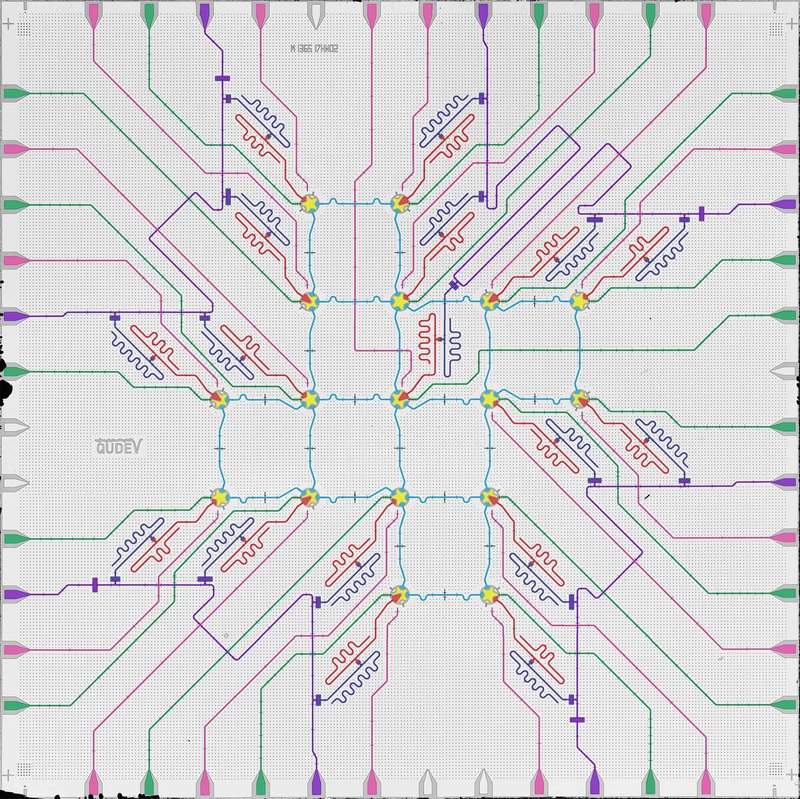Researchers at ETH Zurich have succeeded, for the first time, in quickly and continuously correcting errors in digital quantum systems. This means they have overcome an important hurdle on the road to practical quantum computing. They have just published a paper on this as a preprint on ArXiv.org and submitted it to a journal for publication.
Arxiv – Realizing Repeated Quantum Error Correction in a Distance-Three Surface Code
Sophisticated arrangement of qubits
Previous error correction methods have been unable to simultaneously detect and correct both the fundamental types of error that occur in quantum systems. Wallraff’s team has now presented the first system that can repeatedly detect as well as correct both types of errors. The researchers achieved this important success using a chip, specially produced in ETH Zurich’s own cleanroom laboratory, which features a total of 17 superconducting qubits. The research team performed the error correction with what is known as the surface code – a method in which the quantum information of a qubit is distributed over several physical qubits.
Nine of the chip’s 17 qubits are arranged in a square three-by-three lattice and together form what is known as a logical qubit: the computational unit of a quantum computer. The remaining eight qubits on the chip are offset from them; their task is to detect errors in the system.

If a disturbance occurring in the logical qubit distorts the information, the system recognizes this disturbance as an error. The control electronics then correct the measurement signal accordingly.
“Right now, we’re not correcting the errors directly in the qubits,” admits Sebastian Krinner, a scientist in Wallraff’s group and lead author of the study together with Nathan Lacroix. “But for most arithmetic operations, that’s not even necessary.”
The highly specialized electronics used to control the qubits on the chip were manufactured by ETH spin-off Zurich Instruments. The chip itself is located on the lowest level of a large cryostat – a special cooling device – and operates at a temperature of just 0.01 Kelvin, barely above absolute zero.
As their next step, the ETH researchers now want to build a chip with a five-by-five qubit lattice, which requires correspondingly more complex technology and will also feature more qubits for error correction.

Abstract
Quantum computers hold the promise of solving computational problems which are intractable using conventional methods. For fault-tolerant operation quantum computers must correct errors occurring due to unavoidable decoherence and limited control accuracy. Here, we demonstrate quantum error correction using the surface code, which is known for its exceptionally high tolerance to errors. Using 17 physical qubits in a superconducting circuit we encode quantum information in a distance-three logical qubit building up on recent distance-two error detection experiments. In an error correction cycle taking only 1.1 µs, we demonstrate the preservation of four cardinal states of the logical qubit. Repeatedly executing the cycle, we measure and decode both bit- and phase-flip error syndromes using a minimum-weight perfect-matching algorithm in an error-model free approach and apply corrections in postprocessing. We find a low error probability of 3 % per cycle when rejecting experimental runs in which leakage is detected. The measured characteristics of our device agree well with a numerical model. Our demonstration of repeated, fast and high performance quantum error correction cycles, together with recent advances in ion traps, support our understanding that fault-tolerant quantum computation will be practically realizable.
Arxiv – Building Blocks of a Flip-Chip Integrated Superconducting Quantum Processor (Dec 6, 2021)
Abstract. We have integrated single and coupled superconducting transmon qubits into flipchip modules. Each module consists of two chips — one quantum chip and one control chip — that are bump-bonded together. We demonstrate time-averaged coherence times exceeding 90 µs, single-qubit gate fidelities exceeding 99.9%, and two-qubit gate fidelities above 98.6%. We also present device design methods and discuss the sensitivity of device parameters to
variation in interchip spacing. Notably, the additional flip-chip fabrication steps do not degrade the qubit performance compared to our baseline state-of-the-art in single-chip, planar circuits. This integration technique can be extended to the realization of quantum processors accommodating hundreds of qubits in one module as it offers adequate input/output wiring access to all qubits and couplers.
Conclusion
We have demonstrated the basic building blocks of a flip-chip integrated quantum processor and achieved transmon coherence times and quantum gate fidelities approaching the best flip-chip device performances reported in literature. A comparison of coherence times with those from in-house-fabricated single-chip devices indicates that the qubits are not degraded by the additional flip-chip fabrication steps at this level of performance. The pristine flip-chip environment demonstrated in this work is therefore ready to be used for the investigation and implementation of multi-qubit processors.
SOURCES – ETH Zurich, Arxiv
Written by Brian Wang, Nextbigfuture.com

Brian Wang is a Futurist Thought Leader and a popular Science blogger with 1 million readers per month. His blog Nextbigfuture.com is ranked #1 Science News Blog. It covers many disruptive technology and trends including Space, Robotics, Artificial Intelligence, Medicine, Anti-aging Biotechnology, and Nanotechnology.
Known for identifying cutting edge technologies, he is currently a Co-Founder of a startup and fundraiser for high potential early-stage companies. He is the Head of Research for Allocations for deep technology investments and an Angel Investor at Space Angels.
A frequent speaker at corporations, he has been a TEDx speaker, a Singularity University speaker and guest at numerous interviews for radio and podcasts. He is open to public speaking and advising engagements.

